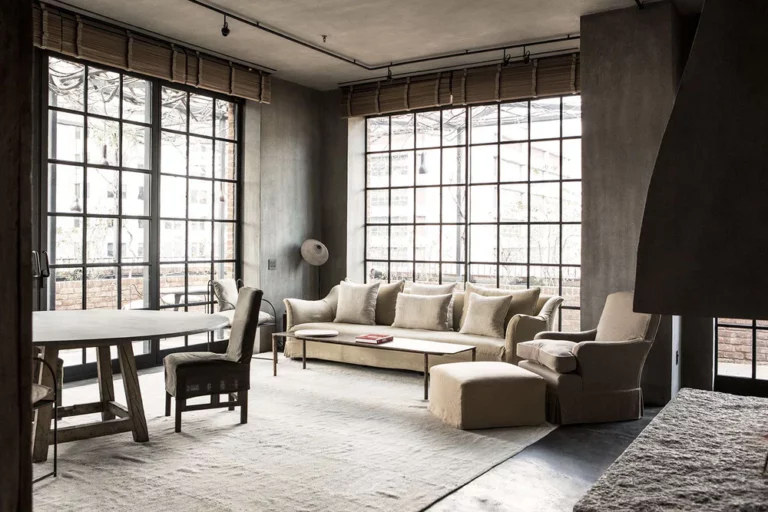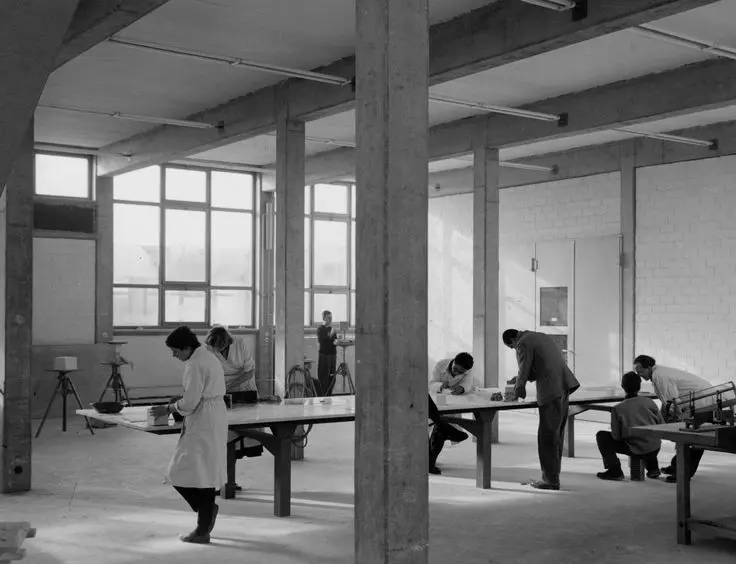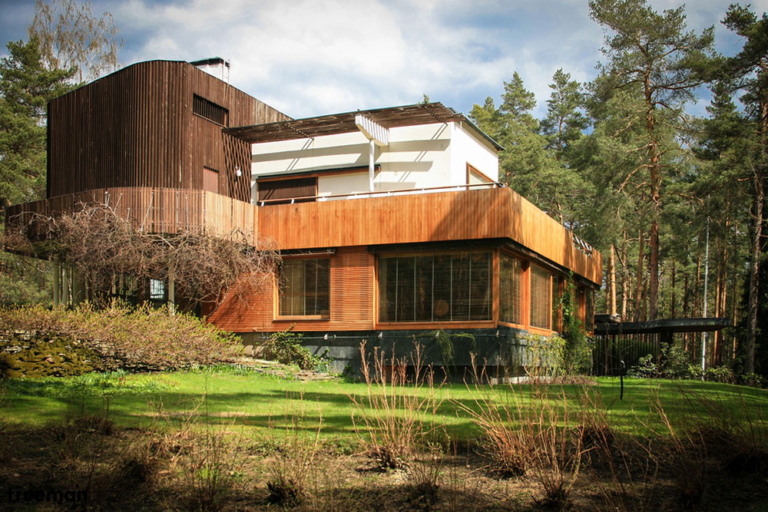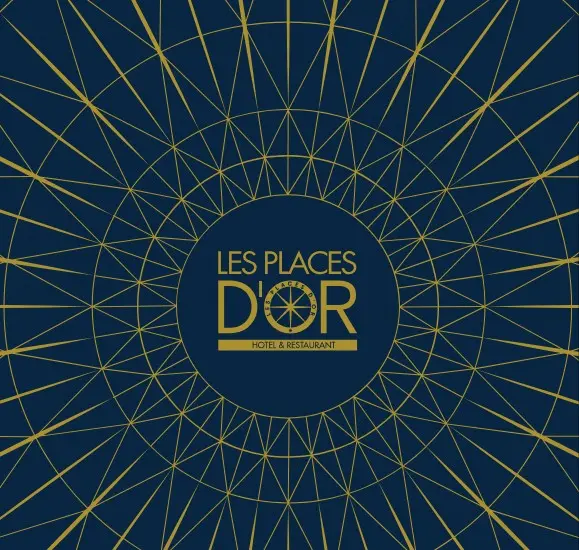Why the Atollo, born in 1977, is still an absolute icon?
There are lamps that you replace. And then there’s the Atollo. An icon of Italian design created in 1977 by the Milanese designer Vico Magistretti for Oluce, it has never been retouched, modified or “reissued”. It is sold today exactly as in 1977, or almost. A metal version is added to the original in blown glass.
Three volumes, millimetric perfection
A cylinder for the base. A cone for the column. A hemisphere for the lampshade. Three elementary geometric shapes that could be drawn in three pencil strokes, but whose balance is so precise that it becomes almost impossible to reproduce without the right proportions.
The relationship between the height of the cylinder and the width of the sphere, the exact angle of the cone and the curvature of the lampshade have been calculated with architectural obsession. Result: the Atollo seems obvious, natural, almost timeless, as if it had always existed.
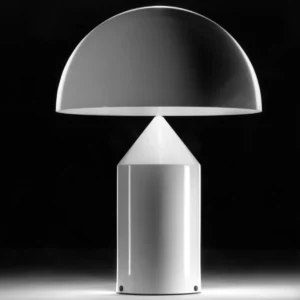
Two interpretations of the same icon: opaline glass or metal
While the Atollo has remained identical in form since the 70s, it now exists in two main versions. The best known, the original, is in blown opaline glass, with a soft, diffused light that envelops the space. The second, more recent, is offered in lacquered metal or aluminum (black, bronze, gold or satin aluminum) and offers a more sculptural reading of the object, with more directional light.
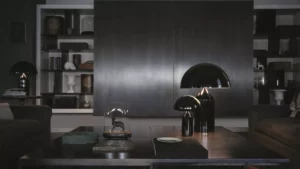
The opaline glass version is often considered the most poetic: it transforms the lamp into an almost immaterial luminous bubble, ideal for bedrooms, living rooms or interiors where a soft ambiance is sought.
The metal version plays more on the graphic presence of the silhouette. It captures light, projects more contrasting shadows and often asserts itself as a more “visible” design object in a contemporary or minimalist space.
In both cases, the structure is identical and manufactured in Italy by Oluce. What changes is the material, the way light propagates, and also… the price.
Always Italian manufacturing, between blown glass and turned metal
The Atollo has been produced since 1977 by Oluce, one of the oldest Italian lighting manufacturers. The company is still based in Lombardy, where each model is manufactured according to a process mastered for nearly fifty years.
In the original version, the lampshade and body are made of mouth-blown opaline glass. This milky material diffuses homogeneous light and creates the enveloping effect that made the model successful. Each glass piece requires precise artisanal know-how to preserve the perfect shape of the cone and sphere.
The metal version, more recent, is based on a structure of turned then lacquered aluminum or brass. Here, the object gains physical presence, the edges are more pronounced, the reflections create sharper contrasts. The light no longer envelops the lamp, it is reflected under the lampshade, which gives a more directional ambiance.

In both cases, the lamp is entirely produced in Italy. The glass version requires more artisanal steps, while the metal version relies more on industrial precision and lacquered finishes.
How much does an Atollo cost? Price according to version and size
Talking about the Atollo means accepting that we’re entering the category of durable design objects, not lamps that you change every two years. Depending on size and material (opaline glass or metal), the price varies significantly.
The smallest table version (model 237, approximately 38 cm high) is around €540 to €650 in opaline glass, and slightly more in metal version. The intermediate version (models 235 / 236, approximately 50 cm high), often considered the most emblematic, ranges between €800 and €950 in opaline, and can rise to around €900 to €1,050 in lacquered metal or satin aluminum.
The large version (model 233, 70 cm high) generally exceeds €1,100 in opaline and can reach €1,500 depending on the metal finish (bronze, black, gold). As for the floor lamp version, it easily crosses the threshold of €1,600 to €1,900, or even more in certain special finishes.
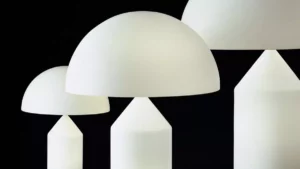
It’s an investment, yes. But it’s also a lamp that you keep, that you transport from one apartment to another, that goes through moves, changes in ambiance and sometimes even generations. An Atollo is not replaced; it settles into a life and stays there. Both the glass and metal versions have three size variations.
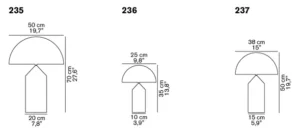
Why it remains an object of desire
The Atollo is one of those objects that you recognize instantly without needing a logo. Its silhouette is enough. It attracts those who know, without ever trying to impress loudly. It plays in the category of cult pieces that don’t shout their status, but impose it through their obviousness.
It also has the rare ability to fit into very different contexts. In a minimalist interior, it becomes a visual anchor point. In a Haussmannian apartment, it introduces a touch of modernity that blends elegantly. In an industrial space, it acts as a rationally placed luminous sculpture. Few lamps manage to cross so many universes without losing their identity.
And then, there’s this simple truth: the Atollo has been copied thousands of times. But no imitation truly reproduces its presence. The proportions are always slightly wrong, the light less pure, the finish flatter. Which proves one thing: there is in this design a balance that tolerates no approximation.
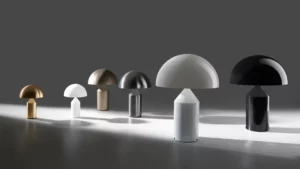
An icon consecrated by museums and the Compasso d’Oro
In 1979, only two years after its creation, the Atollo received the Compasso d’Oro, the most prestigious Italian design award. This is not just another aesthetic reward, but the recognition of an object that checks all the boxes of good design: formal innovation, technical coherence, manufacturing quality and cultural relevance.
Since then, the Atollo has been integrated into the permanent collections of several major institutions, including the MoMA in New York, the Vitra Design Museum in Germany and the Triennale Design Museum in Milan. In other words: it’s a museum piece that has never stopped being manufactured, sold and used in contemporary interiors.
It is one of the rare lamps to belong both to design history and to the daily life of those who choose to live with it.
An icon consecrated by museums and the Compasso d’Oro
In 1979, only two years after its creation, the Atollo received the Compasso d’Oro, the most prestigious Italian design award. This is not just another aesthetic reward, but the recognition of an object that checks all the boxes of good design: formal innovation, technical coherence, manufacturing quality and cultural relevance.
Since then, the Atollo has been integrated into the permanent collections of several major institutions, including the MoMA in New York, the Vitra Design Museum in Germany and the Triennale Design Museum in Milan. In other words: it’s a museum piece that has never stopped being manufactured, sold and used in contemporary interiors.
It is one of the rare lamps to belong both to design history and to the daily life of those who choose to live with it.
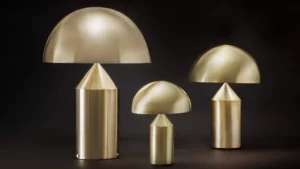
The investment that never goes out of style
Buying an Atollo is not succumbing to a trend. It’s choosing an object that you won’t replace. A lamp that accompanies moves, changes in interior, evolutions in taste, without losing meaning or strength. You don’t “change” an Atollo: you keep it, sometimes pass it on.
Nearly fifty years after its creation, the Atollo proves that a simple idea, conceived with absolute rigor, can become a truly durable object. Three geometric shapes, controlled light, obvious presence: sometimes, perfection simply hides in balance.
OFFICIAL OLUCE BRAND WEBSITE: www.oluce.com

Digital entrepreneur and craft artisan, I use my unconventional background to share my vision of luxury design and interior decoration — one enriched by craftsmanship, history, and contemporary creation. Since 2012, I have been working daily in my workshop on the shores of Lake Annecy, creating bespoke interiors for discerning decorators and private clients.



